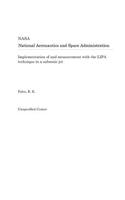
Implementation of and Measurement with the Lipa Technique in a Subsonic Jet
Series:
LIPA (Laser Induced Photochemical Anemometry) was used to measure velocity, vorticity, Reynolds stress, and turbulent intensity distributions in a subsonic jet. The jet region of interest was the area close to the jet-orifice. The LIPA-technique is a nonintrusive quantitative flow visualization technique, consisting of tracking a phosphorescing grid of fluid particles, which is impressed by laser-
NaN
VOLUME
English
Paperback

LIPA (Laser Induced Photochemical Anemometry) was used to measure velocity, vorticity, Reynolds stress, and turbulent intensity distributions in a subsonic jet. The jet region of interest was the area close to the jet-orifice. The LIPA-technique is a nonintrusive quantitative flow visualization technique, consisting of tracking a phosphorescing grid of fluid particles, which is impressed by laser-beams directed into the flow. The phosphorescence of biacetyl gas was used to enable tracking of the impressed light grid. In order to perform measurements in a jet, LIPA was developed and implemented for the specific flow requirements. Nitrogen was used as the carrier gas to avoid quenching of the phosphorescent radiation of the tracer gas biacetyl by ambient oxygen. The use of sulfur dioxide to sensitize phosphorescent emission of biacetyl was examined. Preliminary data was used in a discussion of the potential of the LIPA technique. Falco, R. E. Unspecified Center...
Price Comparison [India]
In This Series
Bestseller Manga
Trending NEWS




















